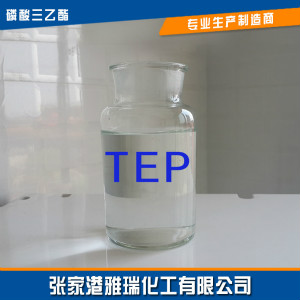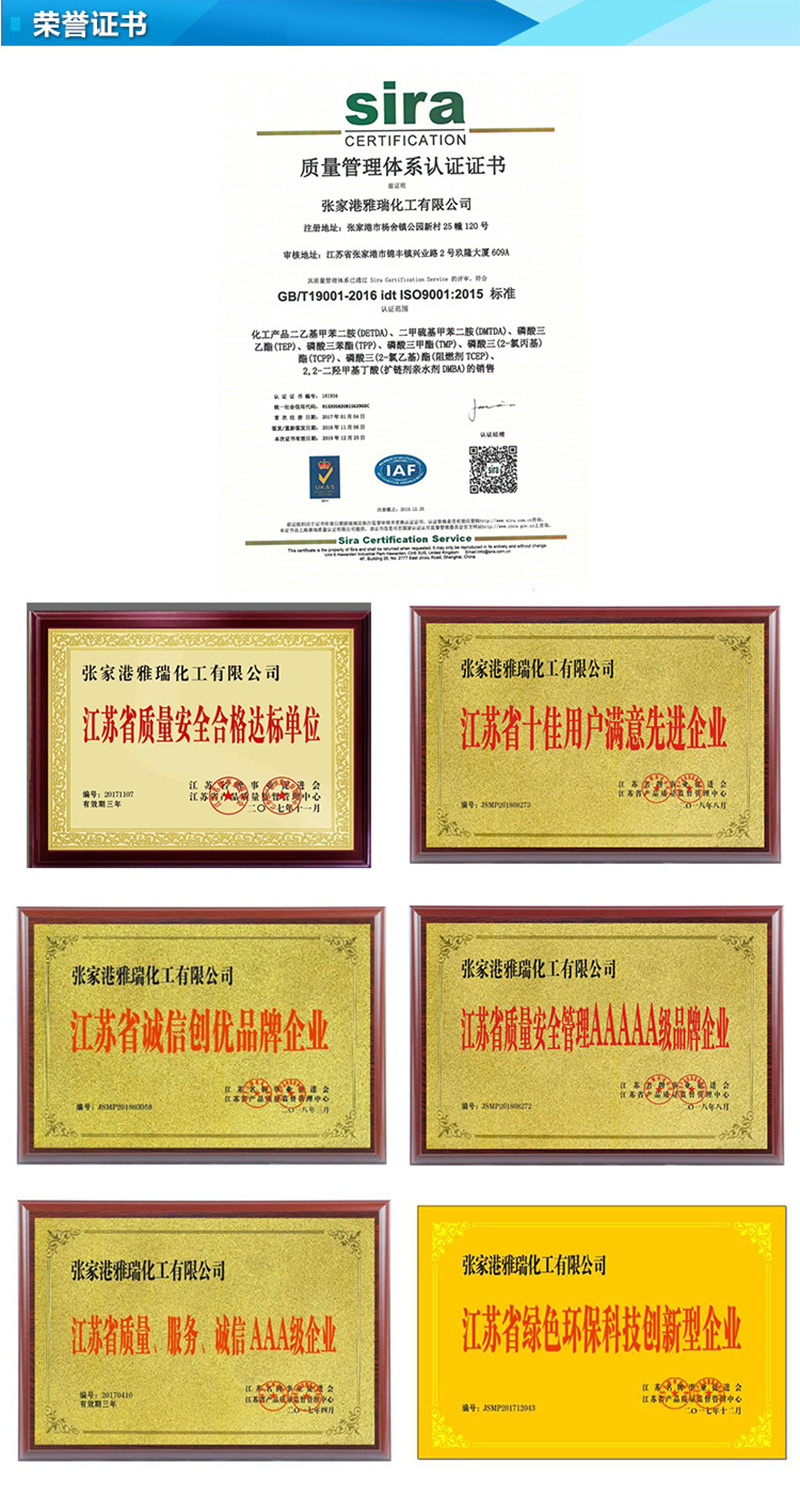Triethyl Phosphate|Flame Retardant TEP

First, The Product Basic Information.
Triethylphosphate; Triethyl Phosphate; Triethoxy Phosphate; Triethyl Phosphate, 98 +%; Triethyl Phosphate, 99 +%; Triethyl Phosphate;Flame Retardant TEP,
English Name: Triethyl Phosphate, ETHYL PHOSPHATE; ETHYL ACID PHOSPHATE; AURORA KA-1638; TEP; PHOSPHORIC ACID TRIETHYL ESTER; TRIETHYL PHOSPHATE; (C2H5O) 3PO; Ethyl Phosphate (EtO)
CAS Number: 78-40-0
Molecular Formula: C6H15O4P
Molecular Weight: 182.15
EINECS Number: 201-114-5
Traits: Colorless Transparent Liquid
Water%: ≤0.20
Color (APHA): ≤ 20
Content (GC%): ≥99.5%
Acid Value (MgKOH / G): ≤0.05
Specific Gravity (20 ° C / 4 ° C): 1.069-1.073
Refractive Index (ND20): 1.4050-1.4070
Raw Materials: To Phosphorus Oxychloride And Ethanol-Based, Two-Step Esterification Synthesis.
Triethyl Phosphate Packaging: Net Weight 200KG / Galvanized Iron Drum (A Small Counter To Play With 16 Tons), 1000KG / IB Barrel (A Small Cabinet 18 Tons) or 23 Tons ISOTANK.
Second, Product Use
Triethyl Phosphate,Flame Retardant TEP Is A High Boiling Solvent, A Plasticizer For Rubber And Plastics, And A Catalyst For The Preparation Of Pesticide Insecticides For Use As An Ethylating Agent For Ketene Production.
(1) Catalyst: Xylene Isomer Catalyst; Polymerization Catalyst For Olefin; Catalyst For Producing Tetraethyl Lead; Catalyst For Producing Carbodiimide; Substitution Reaction Catalyst For Trialkyl Boron And Olefin; Dehydrogenation Of Acetic Acid To Produce Ethylene Ketone; Catalyst For The Polymerization Of Styrene With Conjugated Diene Compounds; And The Use Of Terephthalic Acid And Ethylene Glycol To Prevent Fiber Discoloration.
(2) Solvent: Solvent Of Nitrocellulose And Cellulose Acetate; Solvent Used To Maintain The Life Of The organic Peroxide Catalyst; Solvent For Dispersing Ethylene Fluoride; Peroxide Agent For Curing Resin Of Polyester Resin And Epoxy Resin And Thinner.
(3) Stabilizer: Chlorine-Based Insecticide And Stabilizer; Stabilizer Of Phenolic Resin; Solid Agent Of Sugar Alcohol Resin.
(4) Synthetic Resin: Curing Agent For Xylenol Formaldehyde Resin; Softening Agent For Phenolic Resin Used In Shell Mold; Softener For Vinyl Chloride; Plasticizer For Vinyl Acetate Polymer; Flame Retardant Of Polyester Resin Agent.
(5) Triethyl Phosphate (Flame Retardant TEP) Is A High Boiling Point Solvent, Rubber And Plastic Plasticizer, But Also For The Preparation Of Pesticide Pesticide Raw Materials For Ethylation Reagents And Ketene Production. In Japan, 70% Of The Product Is Used For The Catalyst.
Third, The Production Process
(1) By The Phosphorus Trichloride, Ethanol And Sodium Acetate Role In The Preparation
(1) The Preparation Of Diethyl Chlorophosphate, Phosphorus Trichloride Mixed With Toluene, Stirring By Adding Anhydrous Ethanol, Humidity Control At 30-40 ℃ After Adding To Continue Stirring For 0.5h, The Reaction To Produce Diethyl Phosphite. Followed By The Dropwise Addition Of Dichlorosulfonyl, The Humidity Control At 30-40 ° C Under Reduced Pressure To Remove Excess Dichlorosulfonyl, The Residue Of Diethyl Chlorophosphate.
(2) Preparation Of Triethyl Phosphate, Ethanol Solution Of Sodium Ethoxide Was Added To The Reaction Kettle, And Diethyl Chlorophosphate Was Added Dropwise Under Stirring. The Humidity Was Controlled Below 70 ° C, The PH Was Adjusted To 7-8 With Sodium Ethoxide And Acetic Acid, Add After Stirring 4h. Then Add Cold Water, Stir Evenly After Adding Toluene, Continue Stirring For Some Time, Standing Stratification, Extraction Of The Upper Oil, Dried With Anhydrous Carbonic Acid, Filtered And Recovered Toluene, And Then Vacuum Distillation, Collecting 72-88 ℃ / 0.4 -0.667MPa Of The Product, That Is, The Finished Product.
(2) 100 ML (1.07 Mol) Of Phosphorus Oxychloride Was Charged Into A 250 ML Four-Necked Flask Equipped With A Stirrer And Cooled With Ice Brine To Less Than 15 ° C Then, 92 ML (1.60 Mol) Of Ethanol Was Added Dropwise Under Vacuum. To Another 1000 ML Four-Necked Flask Equipped With A Stirrer, 550 ML (9.63 Mol) Of Ethanol Was Added And The Product Was Added Dropwise Under Normal Pressure And Cooled With Ice-Salt Water To Ensure That The Reaction Humidity Was Less Than 15 ° C. The Reaction Mixture Was Heated At 0.098 MPa Ethanol Recovery. Control The Distillation Humidity Less Than 55 ° C The Recovered Ethanol Was Applied To Esterification 2, And The Remaining Product Was Neutralized With A Liquid Base To Give A PH Of 6-7, Extracted And Distilled To Obtain 165.05 G Of Finished Product. Process Parameters: Phosphorus Oxychloride: Ethanol = 1: 9 (Mol), Reaction Humidity 15 ℃ Reaction Time 1.5h; Product Yield Of About 82%.
(3) Preparation Of Diethyl Chlorophosphate Phosphorus Trichloride Mixed With Toluene, Stirring By Adding Anhydrous Ethanol, The Temperature Control At 30 ~ 40 ℃, After Adding To Continue Stirring For 0.5h, The Reaction To Produce Diethyl Phosphite Ester. And Then Dropping Dichloro-Sulfuryl Chloride, The Temperature Control At 35 ℃, Add Added After The Addition Of Ethanol And Stirring 1h, To Maintain The Temperature At 30 ~ 40 ℃, Under Pressure To Remove The Excess Of Dichlorosyl Chloride, The Residue That Is Chlorophosphate Diethyl Ester.
(4) Preparation Of Triethyl Phosphate Tep Ethanol Sodium Alcohol Solution Was Added To The Reaction Kettle, And Diethyl Phosphite Phosphate Was Added Dropwise Under Stirring. The Temperature Was Controlled At 70 ° C or Lower, And The PH Was Adjusted To 7 ° C With Sodium Ethoxide And Acetic Acid. 8, After Mixing 4h. And Then Adding Cold Water, Stirring Evenly After Adding Toluene, Stirring For Some Time, Standing Stratified, The Extraction Of The Upper Oil, Dried With Anhydrous Potassium Carbonate, Filtered And Recovered Toluene, And Then Vacuum Distillation, Collecting 72 ~ 88 ℃ / 0.4 ~ 0.0667MPa Of The Product, That Was Finished.




